Daring Bakers, November: Tender Potato Bread
At the beginning of every month, a group of blogging bakers of all ability levels called the Daring Bakers are issued a challenge by the month's host. At the end of the month, on the same day, all of the participating Daring Bakers post their results. This month, the marvelous Tanna of My Kitchen in Half Cups hosted the Tender Potato Bread challenge. This is my story ...

We’ve got an exciting lineup for you today, folks!
Our challenger, coming in at 50 pounds lighter than she did a year ago thanks in great part to low-carb/healthy-carb eating habits, Julie "The Snacker" Elefante (no lie--that's my name--it's Spanish-influenced Filipino)!

Aaaaaand in this corner! Weighing in at 12 and 7/8 ounces! Spud "The Carb Bomb" Tater!
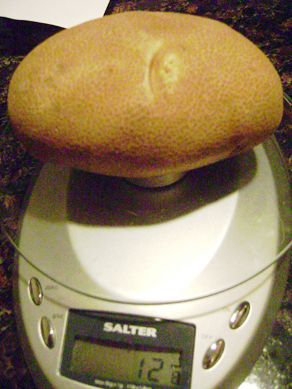
And, ladies and gentlemen, she slices, she dices, she hooks and she jabs, Julie tears Tater to pieces and plunges him into boiling water to soften him up! Ding! Round to Julie!
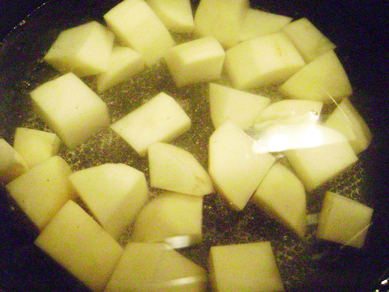
Now, Tater tries to resist, but Julie throws a right! A left! A right! A left! A ... ricer! Tater is simply shredded by Julie’s ricer!
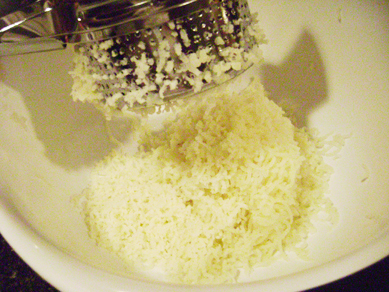
Uh oh! It isn’t Julie’s match yet! Tater ducks under Julie’s fork and ... what’s going on, folks? Emboldened by flour, yeast, and water, he’s showing great resilience! And he makes a comeback!

And, ladies in gentlemen, Tater is definitely back in the game! Julie kneads it, but it seems to knead her back! And she suffers a stunning blow as Tater rips her bowl scraper out of her hand and eats it whole! She punches around frantically, trying to find it, and just barely manages to rescue it, but it was a close one! Retreat to your corners, combatants! To your corners!
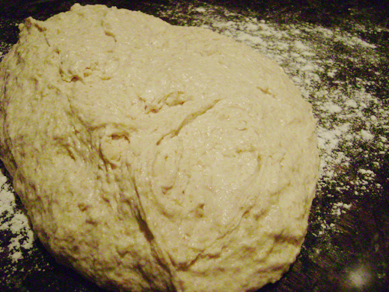
Ohhhh, boy, Julie sure got a rise out of Tater! Look at him—he’s just blowing up! What a reaction!

Can Julie comes back? She wrestles him around on the bench, folds him, rolls him, and lays him into a deathlock, slamming him into the pan!

But wait—what’s this! Tater has henchmen! No problem—Julie can take them, wrestling them into hasty, brutish knots!
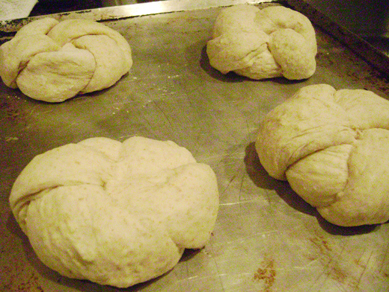
Can we get an instant replay?

Yes, Julie has taken on all of Tater’s henchmen, and Tater himself! What will become of them? It looks like their goose is cooked!
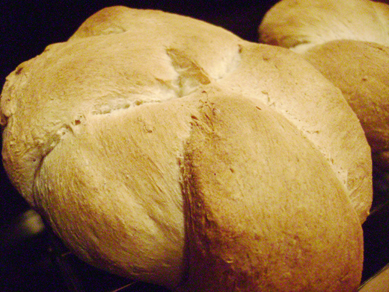
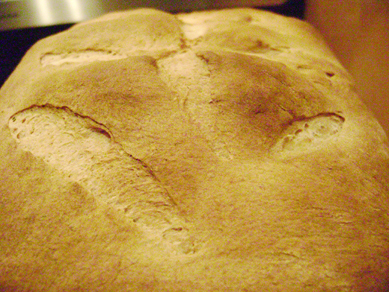

Twelve hours later ... all is peaceful in Julie’s little Burrow. Her One-Wall Kitchen, while still reeling from the aftermath of the Tater match, is coming together. And Tater?

Tater’s in a better place now. With a special cameo from homemade whole wheat bread (the oval-shaped guy in the back left, then there's sliced cucumbers and lemon cucumbers, roasted red peppers, meats, cheeses, grapes, and other stuff).
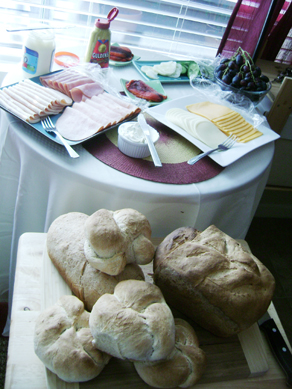
And that’s all that we, gentle viewers, need to know. (Holy crumb!--sorry, that was three-way punny)
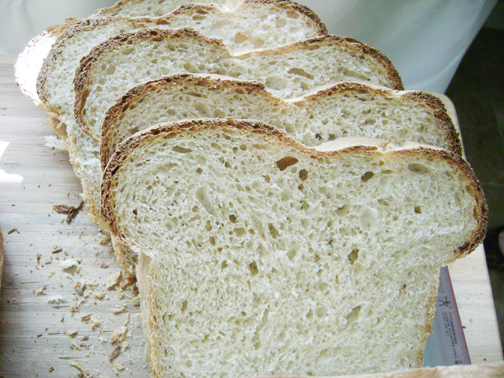
Commercial: Here at the One-Wall Kitche, Julie eats her sammiches with half an animal’s worth of meat. Mmmm ... gooey melted cheese ...
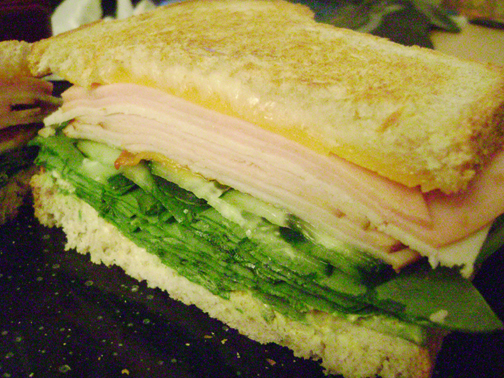
And salad!

Closing observations:
*I wish I'd weighed the potatoes at the farmers' market. Each weight between 10-14 ounces, and I brought four home thinking they weighed less. Since I don't eat many taters, I sent them home with my SAS guests.
*Yes, the dough was sticky. It was ridiculous sticky! But the more I worked it and added flour, the more it firmed up. I added somewhere under 2 additional cups of flour. My bowl scraper really was essential in maintaining order and sanity. Reading through Richard Bertinet's Dough was really inspiring in getting me through the worst of it because he talks about working with sticky dough and letting up firm up naturally as you knead it. The dough was still pretty sticky before its second rise, but after, it was firm enough to gently shape.
*This webpage shows how to make kaiser rolls/rosettes/bread knots almost exactly the way I made them. I just reversed my tucks to get an "innie" roll instead of an "outie."
*I baked the bread late Saturday night and was still good Monday night with the last sandwich. I kept it in my makeshift breadbox, a.k.a. my cake carrier. When my cake carrier's in use, I use my microwave (not in use, of course). And vice versa.
*This is a keeper. The bread was delicious, and I felt a huge sense of achievement after working with this wet dough. It's definitely not daunting anymore!
Visit my fellow Daring Bakers who are fighting the good fight--link to their blogs through our Blogroll!
Tender Potato Bread
from Home Baking: The Artful Mix of Flour & Tradition Around the World by Jeffrey Alford and Naomi Duguid
makes 1 large tender-crumbed pan loaf AND something more; one 10X15 inch crusty yet tender foccacia, 12 soft dinner rolls, or a small pan loaf
4 medium to large floury (baking) potatoes, peeled and cut into chunks.
[Tanna Note: For the beginner bread baker I suggest no more than 8 ounces of potato; for the more advanced no more than 16 ounces. The variety of potatoes you might want to use would include Idaho, Russet & Yukon gold, there are others.]
4 cups (950 ml) water, reserve cooking water
1 tbsp plus 1 tsp salt
2 tsp active dry yeast
6 ½ cups to 8 ½ cups (1 kg to 1350g) unbleached all-purpose flour
1 tbsp unsalted butter, softened
1 cup (130g) whole wheat flour
making the dough (directions for making by hand):
Put potatoes and 4 cups water in a sauce pan and bring to boil. Add 1 tsp salt and cook, half covered, until the potatoes are very tender. Drain potatoes, SAVE POTATO WATER, and mash potatoes well. Measure out 3 cups (750ml) of reserved potato water. Add extra water if needed to make 3 cups. Place the water and mashed potatoes in the bowl you plan to mix the bread dough in. Let cool to lukewarm (70-80°F/21 – 29°C) – stir well before testing the temperature. If using active dry yeast or fresh yeast, mix & stir yeast into cooled water and mashed potatoes & water and let stand 5 minutes. Then add 2 cups of flour to the yeast mix and allow to rest several minutes. If using instant dry yeast, add yeast to 2 cups all-purpose flour and whisk. Add yeast and flour to the cooled mashed potatoes & water and mix well. Allow to rest/sit 5 minutes. Sprinkle in the remaining 1 tbsp salt and the softened butter; mix well. Add the 1 cup whole wheat flour, stir briefly. Add 2 cups of the unbleached all-purpose flour and stir until all the flour has been incorporated. Turn the dough out onto a generously floured surface and knead for about 10 minutes, incorporating flour as needed to prevent sticking. The dough will be very sticky to begin with, but as it takes up more flour from the kneading surface, it will become easier to handle; use a dough scraper to keep your surface clean. The kneaded dough will still be very soft. Place the dough in a large clean bowl or your rising container of choice, cover with plastic wrap or lid, and let rise about 2 hours or until doubled in volume. Turn the dough out onto a well-floured surface and knead gently several minutes. It will be moist and a little sticky.
forming the bread:
Divide the dough into 2 unequal pieces in a proportion of one-third and two-thirds (one will be twice as large as the other). Place the smaller piece to one side and cover loosely.
To shape the large loaf:
Butter a 9 x 5 x 2.5 inch loaf/bread pan. Flatten the larger piece of dough on the floured surface to an approximate 12 x 8 inch oval, then roll it up from a narrow end to form a loaf. Pinch the seam closed and gently place seam side down in the buttered pan. The dough should come about three-quarters of the way up the sides of the pan. Cover with plastic wrap and let rise for 35 to 45 minutes, until puffy and almost doubled in volume.
To make a small loaf with the remainder:
Butter an 8x4X2 inch bread pan. Shape and proof the loaf the same way as the large loaf.
To make rolls:
Butter a 13 x 9 inch sheet cake pan or a shallow cake pan. Cut the dough into 12 equal pieces. Shape each into a ball under the palm of your floured hand and place on the baking sheet, leaving 1/2 inch between the balls. Cover with plastic wrap and let rise for about 35 minutes, until puffy and almost doubled.
To make focaccia:
Flatten out the dough to a rectangle about 10 x 15 inches with your palms and fingertips. Tear off a piece of parchment paper or wax paper a little longer than the dough and dust it generously with flour. Transfer the focaccia to the paper. Brush the top of the dough generously with olive oil, sprinkle on a little coarse sea salt, as well as some rosemary leaves, if you wish and then finally dimple all over with your fingertips. Cover with plastic and let rise for 20 minutes.
baking the bread:
Note about baking order: bake the flat-bread before you bake the loaf; bake the rolls at the same time as the loaf.
Note about baking temps from Tanna: I believe that 450°F(230°C) is going to prove to be too hot for the either the large or small loaf of bread for the entire 40/50 minutes. I am going to put the loaves in at 450°(230°C) for 10 minutes and then turn the oven down to 375°F (190 °C) for the remaining time.
Note about cooling times: Let all the breads cool on a rack for at least 30 minutes before slicing. Rolls can be served warm or at room temperature.
For loaves and rolls:
Dust risen loaves and rolls with a little all-purpose flour or lightly brush the tops with a little melted butter or olive oil (the butter will give a golden/browned crust). Slash loaves crosswise two or three times with a razor blade or very sharp knife and immediately place on the stone, tiles or baking sheet in the oven. Place the rolls next to the loaf in the oven. Bake rolls until golden, about 30 minutes. Bake the small loaf for about 40 minutes. Bake the large loaf for about 50 minutes. Transfer the rolls to a rack when done to cool. When the loaf or loaves have baked for the specified time, remove from the pans and place back on the stone, tiles or baking sheet for another 5 to 10 minutes. The corners should be firm when pinched and the bread should sound hollow when tapped on the bottom.
For focaccia:
Place a baking stone or unglazed quarry tiles, if you have them, if not use a no edged baking/sheet (you want to be able to slide the shaped dough on the parchment paper onto the stone or baking sheet and an edge complicates things). Place the stone or cookie sheet on a rack in the center of the oven and preheat to 450°F/230°C. If making focaccia, just before baking, dimple the bread all over again with your fingertips. Leaving it on the paper, transfer to the hot baking stone, tiles or baking sheet. Bake until golden, about 10 minutes. Transfer to a rack (remove paper) and let cool at least 10 minutes before serving.

We’ve got an exciting lineup for you today, folks!
Our challenger, coming in at 50 pounds lighter than she did a year ago thanks in great part to low-carb/healthy-carb eating habits, Julie "The Snacker" Elefante (no lie--that's my name--it's Spanish-influenced Filipino)!
Aaaaaand in this corner! Weighing in at 12 and 7/8 ounces! Spud "The Carb Bomb" Tater!

And, ladies and gentlemen, she slices, she dices, she hooks and she jabs, Julie tears Tater to pieces and plunges him into boiling water to soften him up! Ding! Round to Julie!

Now, Tater tries to resist, but Julie throws a right! A left! A right! A left! A ... ricer! Tater is simply shredded by Julie’s ricer!

Uh oh! It isn’t Julie’s match yet! Tater ducks under Julie’s fork and ... what’s going on, folks? Emboldened by flour, yeast, and water, he’s showing great resilience! And he makes a comeback!

And, ladies in gentlemen, Tater is definitely back in the game! Julie kneads it, but it seems to knead her back! And she suffers a stunning blow as Tater rips her bowl scraper out of her hand and eats it whole! She punches around frantically, trying to find it, and just barely manages to rescue it, but it was a close one! Retreat to your corners, combatants! To your corners!

Ohhhh, boy, Julie sure got a rise out of Tater! Look at him—he’s just blowing up! What a reaction!

Can Julie comes back? She wrestles him around on the bench, folds him, rolls him, and lays him into a deathlock, slamming him into the pan!

But wait—what’s this! Tater has henchmen! No problem—Julie can take them, wrestling them into hasty, brutish knots!

Can we get an instant replay?

Yes, Julie has taken on all of Tater’s henchmen, and Tater himself! What will become of them? It looks like their goose is cooked!



Twelve hours later ... all is peaceful in Julie’s little Burrow. Her One-Wall Kitchen, while still reeling from the aftermath of the Tater match, is coming together. And Tater?

Tater’s in a better place now. With a special cameo from homemade whole wheat bread (the oval-shaped guy in the back left, then there's sliced cucumbers and lemon cucumbers, roasted red peppers, meats, cheeses, grapes, and other stuff).

And that’s all that we, gentle viewers, need to know. (Holy crumb!--sorry, that was three-way punny)

Commercial: Here at the One-Wall Kitche, Julie eats her sammiches with half an animal’s worth of meat. Mmmm ... gooey melted cheese ...

And salad!

Closing observations:
*I wish I'd weighed the potatoes at the farmers' market. Each weight between 10-14 ounces, and I brought four home thinking they weighed less. Since I don't eat many taters, I sent them home with my SAS guests.
*Yes, the dough was sticky. It was ridiculous sticky! But the more I worked it and added flour, the more it firmed up. I added somewhere under 2 additional cups of flour. My bowl scraper really was essential in maintaining order and sanity. Reading through Richard Bertinet's Dough was really inspiring in getting me through the worst of it because he talks about working with sticky dough and letting up firm up naturally as you knead it. The dough was still pretty sticky before its second rise, but after, it was firm enough to gently shape.
*This webpage shows how to make kaiser rolls/rosettes/bread knots almost exactly the way I made them. I just reversed my tucks to get an "innie" roll instead of an "outie."
*I baked the bread late Saturday night and was still good Monday night with the last sandwich. I kept it in my makeshift breadbox, a.k.a. my cake carrier. When my cake carrier's in use, I use my microwave (not in use, of course). And vice versa.
*This is a keeper. The bread was delicious, and I felt a huge sense of achievement after working with this wet dough. It's definitely not daunting anymore!
Visit my fellow Daring Bakers who are fighting the good fight--link to their blogs through our Blogroll!
Tender Potato Bread
from Home Baking: The Artful Mix of Flour & Tradition Around the World by Jeffrey Alford and Naomi Duguid
makes 1 large tender-crumbed pan loaf AND something more; one 10X15 inch crusty yet tender foccacia, 12 soft dinner rolls, or a small pan loaf
4 medium to large floury (baking) potatoes, peeled and cut into chunks.
[Tanna Note: For the beginner bread baker I suggest no more than 8 ounces of potato; for the more advanced no more than 16 ounces. The variety of potatoes you might want to use would include Idaho, Russet & Yukon gold, there are others.]
4 cups (950 ml) water, reserve cooking water
1 tbsp plus 1 tsp salt
2 tsp active dry yeast
6 ½ cups to 8 ½ cups (1 kg to 1350g) unbleached all-purpose flour
1 tbsp unsalted butter, softened
1 cup (130g) whole wheat flour
making the dough (directions for making by hand):
Put potatoes and 4 cups water in a sauce pan and bring to boil. Add 1 tsp salt and cook, half covered, until the potatoes are very tender. Drain potatoes, SAVE POTATO WATER, and mash potatoes well. Measure out 3 cups (750ml) of reserved potato water. Add extra water if needed to make 3 cups. Place the water and mashed potatoes in the bowl you plan to mix the bread dough in. Let cool to lukewarm (70-80°F/21 – 29°C) – stir well before testing the temperature. If using active dry yeast or fresh yeast, mix & stir yeast into cooled water and mashed potatoes & water and let stand 5 minutes. Then add 2 cups of flour to the yeast mix and allow to rest several minutes. If using instant dry yeast, add yeast to 2 cups all-purpose flour and whisk. Add yeast and flour to the cooled mashed potatoes & water and mix well. Allow to rest/sit 5 minutes. Sprinkle in the remaining 1 tbsp salt and the softened butter; mix well. Add the 1 cup whole wheat flour, stir briefly. Add 2 cups of the unbleached all-purpose flour and stir until all the flour has been incorporated. Turn the dough out onto a generously floured surface and knead for about 10 minutes, incorporating flour as needed to prevent sticking. The dough will be very sticky to begin with, but as it takes up more flour from the kneading surface, it will become easier to handle; use a dough scraper to keep your surface clean. The kneaded dough will still be very soft. Place the dough in a large clean bowl or your rising container of choice, cover with plastic wrap or lid, and let rise about 2 hours or until doubled in volume. Turn the dough out onto a well-floured surface and knead gently several minutes. It will be moist and a little sticky.
forming the bread:
Divide the dough into 2 unequal pieces in a proportion of one-third and two-thirds (one will be twice as large as the other). Place the smaller piece to one side and cover loosely.
To shape the large loaf:
Butter a 9 x 5 x 2.5 inch loaf/bread pan. Flatten the larger piece of dough on the floured surface to an approximate 12 x 8 inch oval, then roll it up from a narrow end to form a loaf. Pinch the seam closed and gently place seam side down in the buttered pan. The dough should come about three-quarters of the way up the sides of the pan. Cover with plastic wrap and let rise for 35 to 45 minutes, until puffy and almost doubled in volume.
To make a small loaf with the remainder:
Butter an 8x4X2 inch bread pan. Shape and proof the loaf the same way as the large loaf.
To make rolls:
Butter a 13 x 9 inch sheet cake pan or a shallow cake pan. Cut the dough into 12 equal pieces. Shape each into a ball under the palm of your floured hand and place on the baking sheet, leaving 1/2 inch between the balls. Cover with plastic wrap and let rise for about 35 minutes, until puffy and almost doubled.
To make focaccia:
Flatten out the dough to a rectangle about 10 x 15 inches with your palms and fingertips. Tear off a piece of parchment paper or wax paper a little longer than the dough and dust it generously with flour. Transfer the focaccia to the paper. Brush the top of the dough generously with olive oil, sprinkle on a little coarse sea salt, as well as some rosemary leaves, if you wish and then finally dimple all over with your fingertips. Cover with plastic and let rise for 20 minutes.
baking the bread:
Note about baking order: bake the flat-bread before you bake the loaf; bake the rolls at the same time as the loaf.
Note about baking temps from Tanna: I believe that 450°F(230°C) is going to prove to be too hot for the either the large or small loaf of bread for the entire 40/50 minutes. I am going to put the loaves in at 450°(230°C) for 10 minutes and then turn the oven down to 375°F (190 °C) for the remaining time.
Note about cooling times: Let all the breads cool on a rack for at least 30 minutes before slicing. Rolls can be served warm or at room temperature.
For loaves and rolls:
Dust risen loaves and rolls with a little all-purpose flour or lightly brush the tops with a little melted butter or olive oil (the butter will give a golden/browned crust). Slash loaves crosswise two or three times with a razor blade or very sharp knife and immediately place on the stone, tiles or baking sheet in the oven. Place the rolls next to the loaf in the oven. Bake rolls until golden, about 30 minutes. Bake the small loaf for about 40 minutes. Bake the large loaf for about 50 minutes. Transfer the rolls to a rack when done to cool. When the loaf or loaves have baked for the specified time, remove from the pans and place back on the stone, tiles or baking sheet for another 5 to 10 minutes. The corners should be firm when pinched and the bread should sound hollow when tapped on the bottom.
For focaccia:
Place a baking stone or unglazed quarry tiles, if you have them, if not use a no edged baking/sheet (you want to be able to slide the shaped dough on the parchment paper onto the stone or baking sheet and an edge complicates things). Place the stone or cookie sheet on a rack in the center of the oven and preheat to 450°F/230°C. If making focaccia, just before baking, dimple the bread all over again with your fingertips. Leaving it on the paper, transfer to the hot baking stone, tiles or baking sheet. Bake until golden, about 10 minutes. Transfer to a rack (remove paper) and let cool at least 10 minutes before serving.
Comments
Isn't it funny how we're both on lower carb diets but still manage to fend these DB challenges? (I've plateaud by the way and hoping to push past it).
Great work once again. :)
Glad you wrestled them into knots!
xoxo
Congratulations on your bread!
how did your thanksgiving go? Did you do a good job resisting yummy food? Did you have time to workout? I have some questions about the south beach diet. If it's not to much of a bother could you direct me to where I can post you those questions. You can find my email in my blog.
Great job!
Cheers,
Rosa
Lovely bread!
I love the shape your loaf got, very cool. How did you shape your knots? It seems different than a standard knot.
Christina ~ She Runs, She Eats
-jen at use real butter
Love the sarnie, sorry sammich, though if you took out all the green stuff you cold put more meat in. Rookie mistake, but now you know ;-)
Oh and I love your avatar.
tablebread.blogspot.com
Alas- I need photoshop- and a ricer- it appears-
I love your pictures, they are neater than sliced bread. (Gah!)
Such a fun post! I love the rosettes you made. I'll have to try that.
I hope that you had fun in California.
Nora
btw do you always put so much on your sandwiches AND lose wait? Sandwich looks delish btw!
Gretchen Noelle, thank you! It's a Spanish word, but my ancestors, Filipinos, adopted it as a last name under Spanish colonial rule in the 1700s. I don't think the word, which means "elephant" in English, was ever used as a last name until then.
Simona, that's my policy, too!
Nazca, glad the ether helped you out! =D I'm still learning my sandwich fundamentals. Sometimes, it's all green! Oy!
Mandy, there's not much room here for tenets, but you can certainly stop in!
Linda, absolutely not! For the first few months of my weight loss, I was strictly healthy carb and low-fat. I never would've eaten potatoes, white flour, mayo, full-fat cheese, or full-fat lunch meat. If I had, I never would've lost 30 pounds during that time! Once I hit the 30-lb weight loss mark, I started allowing myself occasional indulgences--maybe a cookie every other week or so. Once I hit the 50-lb mark 5 months later, I allowed a bit more. Most of my meals are healthy carb and low-fat. I cook 95% of the food I eat, and a good deal of that comes from local, organic, seasonal produce--mostly vegetable matter. All this comes hand in hand with working out 45-90 minutes, sometimes more, seven days a week, combining cardio, weight training, and yoga. Trust me--I recognized this sandwich as an indulgence, but it was totally guilt-free. =D
--Dove (of the infamous livejournal paletteable - should I switch to blogger? Really?)
great pics!